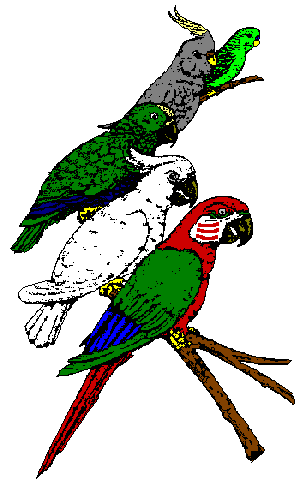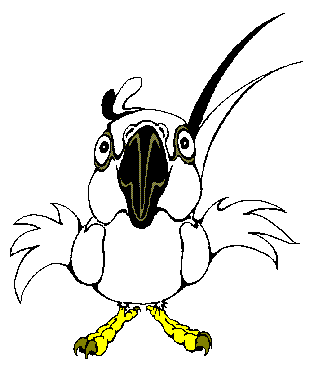ARE PARROTS DOMESTIC ANIMALS?

Parrots in Nature
There are approximately 330 varieties of parrots, all classified under the scientific name Psittaciformes. This includes such types as lovebirds, parakeets, cockatiels, cockatoos, Amazonian parrots, African Grey parrots, and macaws.
Parrots are widespread in the tropics of both the northern and southern hemispheres, with the majority living in the lower reaches of the rainforests.
The greatest number of varieties live in central and South Africa and Australia-relatively few types appear in Asia and the rest of Africa.
Although there are numerous species of parrots, many are endangered, nearly extinct, or have become extinct . The primary causes for this are the destruction of the rain forest and the capture of large numbers of wild parrots for trade and export.
This illegal practice is widespread, and document forgery is very common.
Except for grass parakeets and falcon parakeets, all varieties of parrots are protected by CITES (Convention on International Trade in Endangered Species of Wild Fauna and Flora) and are thus strictly regulated. On our web pages, you will see the CITES status of each variety. There is also more information on the web page "law" concerning import restrictions and the parrot trade as they relate to CITES.
The NOP also takes in parrots confiscated by agencies which enforce the CITES regulations, such as the General Inspectors Service and Customs.

How you recognize a parrot.
Parrots come in various sizes, from the largest macaw-a meter in length-to the smallest love bird, only about two centimeters tall.
They all have a number of distinguishing features, the most notable being their beaks and feet.
All parrots have a hooked beak: this makes it very easy for them to break open pits and nuts. The beak also serves as a "third foot" for climbing.
All parrots have opposing toes (climbing birds): this means that the two outermost toes point backward and the two innermost toes point forward. This allows them to hold onto branches very well. Parrots can also hold food with a foot while they eat.
Next follows a short description of a number of parrot varieties which people often keep as pets. A special lexicon is available for further details such as designation, range, common names, and scientific naming (in five

Cacatuidae - Cockatoos
The so-called "White Cockatoos" belong to the genus "Cacatua" which are called "White and Black-beaked Cockatoos" in the Netherlands. The feathers are in general white or a pale salmon color. They are of medium to large size with a short, wide tail and a long, round-topped wing. The male and female look a lot alike and their young look like the adults. This type of parrot lives mainly in Australia, New Guinea, the surrounding islands, and the Philippines.
The so-called "Cockatiels" belong to the genus "Nymphicus". They are the second most common parrot kept as pets. They are of medium size and quite parrot-like in build, slender, with a long, strong, graduated arrangement of tail feathers. The wings are long and pointed, and the beak is small and narrow. All cockatiels have a tufted head. This type of bird is found mainly in Australia. According to some authorities, this variety should not be catoegorized under the Cacatuidae, but be seen as a genus all to itself.
Loriidae
The so-called "Lories" all belong to the family "Loriidae" . They all have sturdy, thick, and shiny feathers. Color varies widely. In the wild, lories are found in loud, raucous groups, which quickly move from one tree to another. Lories almost never spend time on the ground. They eat primarily pollen, nectar, and fruit, and they have a specially shaped tongue which helps them gather their food. The beak is relatively extensive and narrow, and the front of the tongue has a large numbers of extensive papillae, which form a sort of brushlike whole. These birds are found only on certain islands in Oceania such as New Guinea, Australia, and the Solomon Islands. The Lories are rarely kept as pets.
Psittacidae
The so-called "Amazon Parrots" all belong to the genus "Amazona". This very well known type is medium to large, and has a sturdy body. They have a large beak and a small, slender, rounded tail. The bare nostrils are prominent as well as a definite shortening of the upper jaw. The wings are broad and rounded. The feathers are green for the most part. These birds appear in South America in the Amazon basin, hence their name.
The so-called "Macaws" all belong to the genus "Ara". The genus is probably the most striking and well known of all the parrots. The parrots come in all sizes from small to very large, and they all have a long, pointed tail with a graduated arrangement of feathers. There are numerous types and colors of macaws. Body proportions are extensive and evenly divided. The difference between male and female is not visible and can only be determined by endoscopic examination by a trained veterinarian. The young resemble mature macaws. Macaws are only found in South America. Macaws, with their powerful presence, are often seen as status symbols and are often used in commercials.
The so-called "African Grey Parrot" belongs to the genus "Psittacus". Three varieties are known. The African Grey is very popular because they tend to be good talkers. The African Grey is a fairly large, sometimes massive parrot, with a very short square (red) tail. The feathers are grey and the nose is bare. There is no visible difference between male and female.
The "regular" African Grey (Congo African Grey..ie CAG) has a black beak, light grey feathers, and a squared bright red tail.
The Timneh (TAG) has a white or horn colored upper beak, dark grey feathers, and a squared dark red tail. The Timneh is somewhat smaller than the Congo African Grey and usually somewhat shyer.
The so-called "Love Birds" belong to the genus "Agapornis". Lovebirds are also well known and often kept as pets. There is a great variety of coloration. They often have a scale of very hard and short chirping sounds. These little parrots with a length of 15 centimeters are best described as small and thick set with a very short rounded tail. The beak is larger in proportion than it ought to be. Lovebirds prefer to be in groups where they always sit next to each other. They have a very hard bite, but are also very easy to tame because they learn easily.
Finally, the birds belonging to the genus "Melopsittacus", better known as "Parakeets" or "budgies". This small, parrot-like bird is available in many different colors, and is the most common bird found as a house pet. In the Netherlands alone, there are over one million, some in aviaries, some in cages at home. These intelligent animals are loved by their owners because they are easy to train to sit on your hand or shoulder, and some can even learn to talk. All parakeets have graduated tail feathers.
History of the parrot in Europe
Parrots have been popular with people for a very long time. The early explorers took parrots along on their distant journeys. These animals were already popular with artists, poets, and students as early as 300 B.C. During the Roman Empire, a parrot that could speak Latin was prized as a house pet and cost more than a slave.
During the Renaissance, more and more types of parrots came to Europe as the explorers' journeys went farther and farther. Talking parrots received a special status from the church, and their value was so high that only the very wealthy could afford them.
The average citizen first could afford a parrot in 1840, when parakeets became widely available. They are yet today the most popular of the parrot family, with more than one million in the Netherlands alone. While parakeets have adjusted well to captivity, there are still many problems keeping the larger parrots.

Why do we buy parrots?
Most everyone either has a friend or family member with a parrot. Sometimes these people are totally crazy about their pet (rightly so). When such an intimate relationship develops, one can teach a very intelligent parrot a few words. Parrots can have a wonderfully loving character, and above all, they are imposing and colorful pets. People also desire parrots as status symbols. What often goes untold is that these good owners have given their parrots a great deal of time and attention and must always continue to do so.

